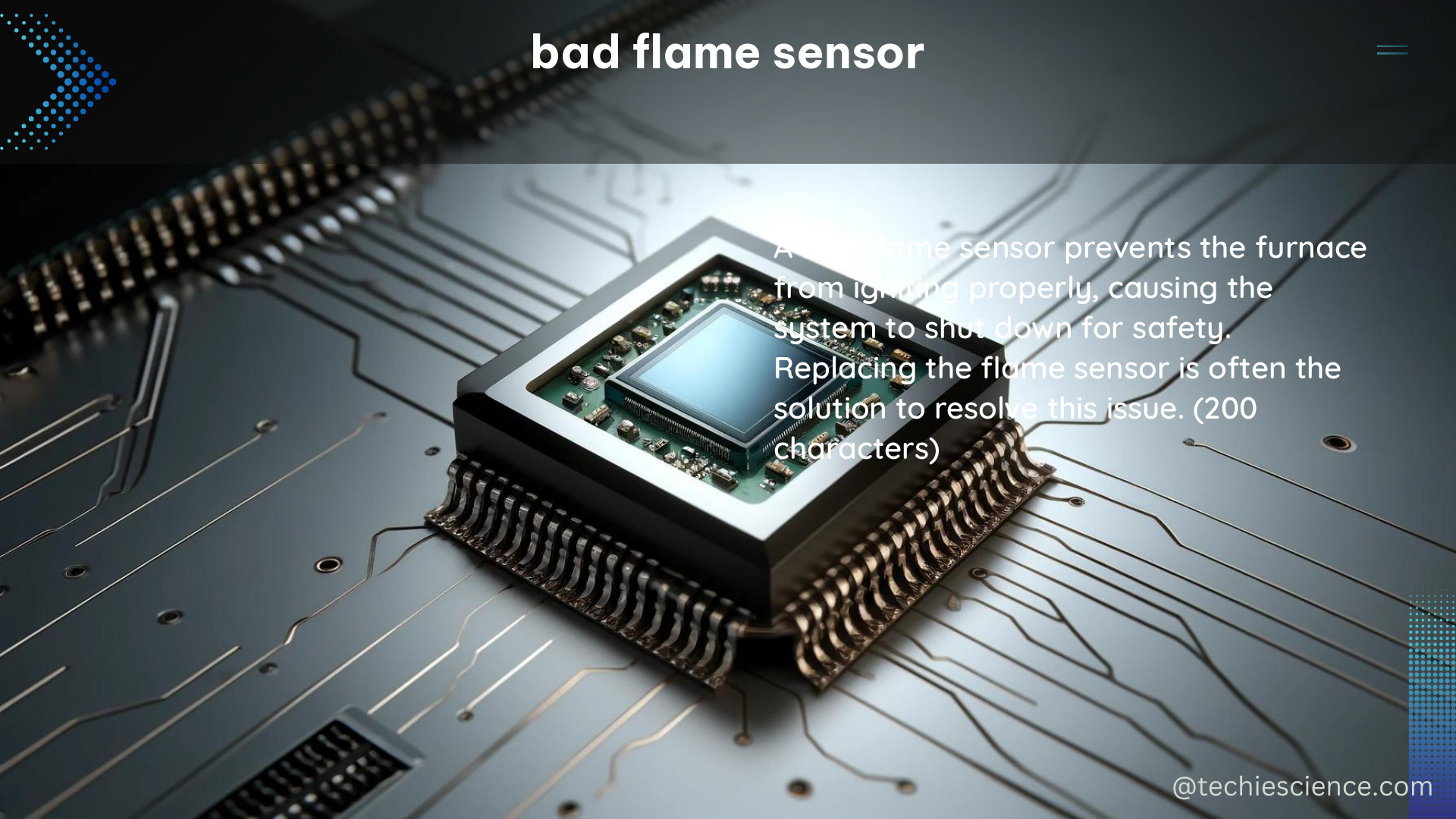A flame sensor is a critical component in gas-fired appliances, responsible for detecting the presence of a flame and ensuring safe and efficient operation. When a flame sensor malfunctions, it can lead to various issues, such as the appliance not igniting, the flame turning on and off, or the appliance shutting down unexpectedly. Understanding the technical specifications, testing procedures, and proper cleaning methods can help homeowners and HVAC professionals effectively troubleshoot and maintain a bad flame sensor.
Technical Specifications of Flame Sensors
Flame sensors typically have the following technical specifications:
| Specification | Range |
|---|---|
| Sensing Range | 0.5 to 2 inches from the flame |
| Operating Voltage | 24 to 120 VAC |
| Current Draw | 0.5 to 5 mA |
| Response Time | 0.5 to 2 seconds |
| Operating Temperature | 32°F to 212°F (0°C to 100°C) |
| Material | Stainless Steel, Ceramic, or Nickel-Plated Brass |
| Mounting Configuration | Threaded, Bayonet, or Flange |
It’s important to note that these specifications can vary depending on the manufacturer and the specific model of the flame sensor.
Measuring Flame Signal

The flame signal is a crucial indicator of the flame sensor’s performance. To measure the flame signal, you’ll need a microamp (μA) meter. Here’s how to do it:
- Locate the flame sensor and identify the wire connected to it.
- Disconnect the wire from the flame sensor.
- Connect the positive lead of the microamp meter to the wire and the negative lead to the flame sensor.
- Turn on the appliance and observe the flame signal reading.
A healthy flame sensor should read above 5 μA. If the reading is below 5 μA, it’s likely that the flame sensor is dirty and requires cleaning.
Cleaning the Flame Sensor
Cleaning the flame sensor is a straightforward process that can be done by following these steps:
- Turn off the gas and power to the appliance: Before starting the cleaning process, ensure that the gas and power to the appliance are turned off to prevent any safety hazards.
- Locate the flame sensor: The flame sensor is typically located near the burners and can be identified by a metal rod extending into the flame.
- Disconnect the flame sensor: Disconnect the wire connected to the flame sensor, being careful not to damage the wire or the sensor.
- Clean the flame sensor: Use a 3M Scotchbrite pad or a piece of grey Scotch Brite to polish the sensor, being careful not to use anything too abrasive. The sensor needs to be cool to the touch when cleaning to prevent damage to the Scotchbrite pad and leaving a residue on the flame rod.
- Reinstall the flame sensor: Once the sensor is clean, reinstall it and reconnect the wire.
- Check the flame signal: Use a microamp meter to check the flame signal, ensuring that it is above 5 μA.
It’s important to avoid using anything too abrasive, like heavy grit sandpaper, as it can wear down the coating and cause the sensor to get dirty at a more rapid rate in the future.
Troubleshooting a Bad Flame Sensor
If the flame sensor continues to malfunction after cleaning, there are a few additional steps you can take to troubleshoot the issue:
- Check for Exhaust Obstructions: Obstructions in the exhaust system can prevent proper airflow, which can affect the flame sensor’s ability to detect the flame. Inspect the exhaust vent and clear any blockages.
- Test the Flame Sensor: Use a multimeter to test the flame sensor’s resistance and continuity. If the sensor is not functioning correctly, it may need to be replaced.
- Inspect the Wiring: Check the wiring between the flame sensor and the control board for any damage or loose connections. Repair or replace the wiring as needed.
- Replace the Flame Sensor: If the flame sensor continues to malfunction after cleaning and troubleshooting, it may need to be replaced. Ensure that the replacement flame sensor is compatible with the appliance.
Remember, safety should always be the top priority when working with gas-fired appliances. If you’re not comfortable performing these tasks, it’s best to consult a qualified HVAC professional.
Conclusion
Maintaining a healthy flame sensor is crucial for the safe and efficient operation of gas-fired appliances. By understanding the technical specifications, measuring the flame signal, and following the proper cleaning and troubleshooting procedures, homeowners and HVAC professionals can prevent potential safety hazards and ensure the longevity of the equipment.
References
- Measuring Flame Signal and Cleaning Flame Sensors | Deppmann. (2017, February 17). Retrieved May 10, 2024, from https://www.deppmann.com/blog/service-tip-of-the-month/measuring-flame-signal-cleaning-flame-sensors/
- Flame turns on then off , bad flame sensor? : r/hvacadvice – Reddit. (2023, December 20). Retrieved May 10, 2024, from https://www.reddit.com/r/hvacadvice/comments/18mw9j3/flame_turns_on_then_off_bad_flame_sensor/
- I am getting a code, flame sensor out of sequence. The – JustAnswer. (2018, September 06). Retrieved May 10, 2024, from https://www.justanswer.com/hvac/bk04i-getting-code-flame-sensor-sequence.html
- How can I bench test a Flame Sensor (Flame Rectification) – Electronics Stack Exchange. (2016, July 01). Retrieved May 10, 2024, from https://electronics.stackexchange.com/questions/243910/how-can-i-bench-test-a-flame-sensor-flame-rectification
- checking micro amps on flame sensor – HVAC-Talk. (2021, March 06). Retrieved May 10, 2024, from https://hvac-talk.com/vbb/threads/83745-checking-micro-amps-on-flame-sensor

The lambdageeks.com Core SME Team is a group of experienced subject matter experts from diverse scientific and technical fields including Physics, Chemistry, Technology,Electronics & Electrical Engineering, Automotive, Mechanical Engineering. Our team collaborates to create high-quality, well-researched articles on a wide range of science and technology topics for the lambdageeks.com website.
All Our Senior SME are having more than 7 Years of experience in the respective fields . They are either Working Industry Professionals or assocaited With different Universities. Refer Our Authors Page to get to know About our Core SMEs.